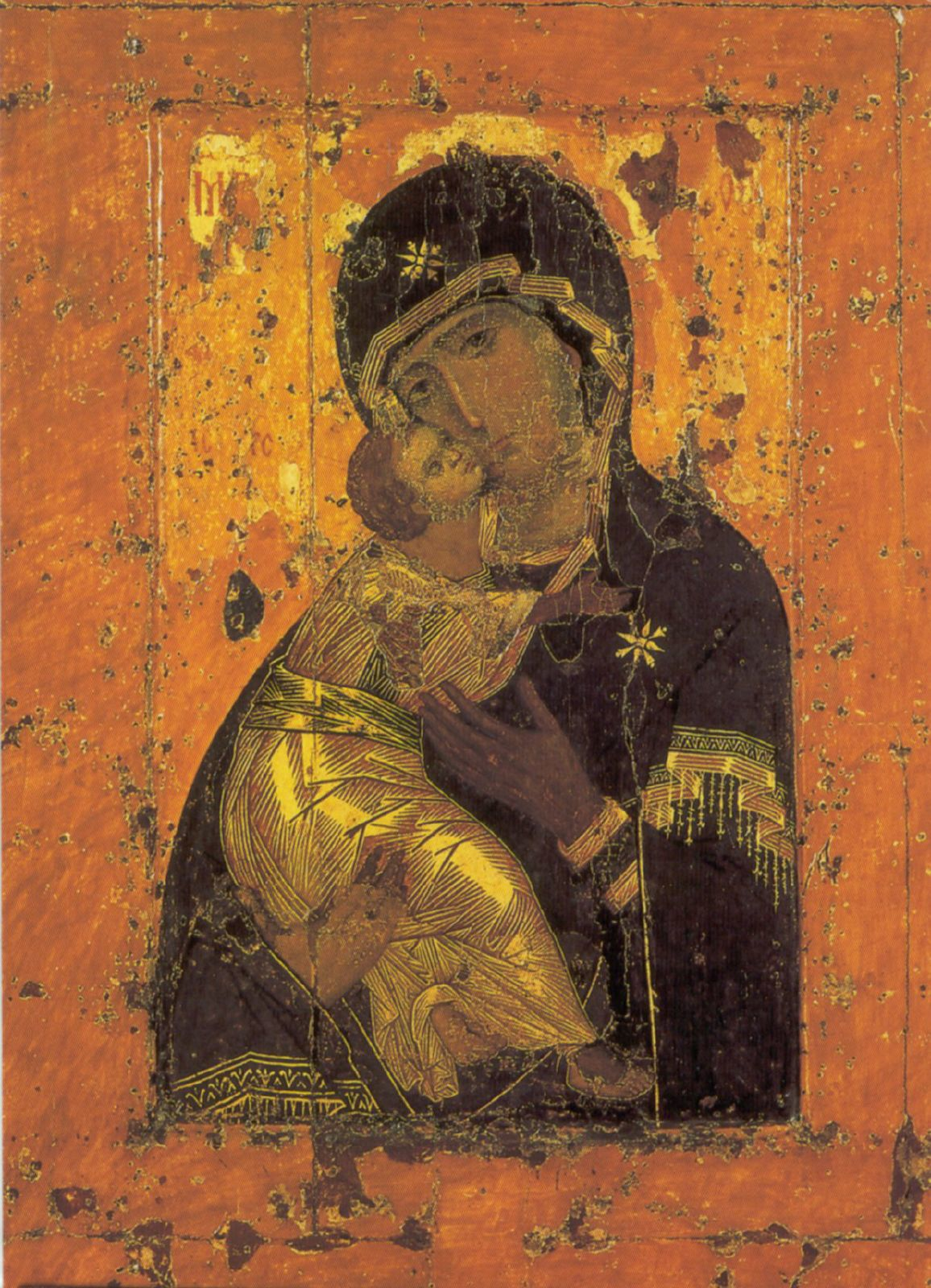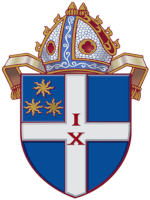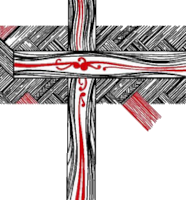Fr Peter Beck presided and preached at the 10am service for Mothering Sunday. The Gospel reading was taken from Luke 1:26-38.
Read on for the sermon.
Sermon
Today is Mothering Sunday. I have a copy of Our Lady of Vladimir icon, which I bought in 1966 on one of my first days as an undergraduate at Oxford .It has been part of my journey ever since and now hangs in the doorway of our hall opposite a copy of Rublev’s icon of the Trinity. The Virgin of Vladimir is one of the most famous and most beautiful of all icons of the Mother of God. She is depicted cheek to cheek with the Divine Child, whose arms caress her. Tender indeed, yet the image is strong and noble in workmanship, completely free from “sweetness” and sentimentality.

Throughout the history of the Church, Mary has not only been a key figure in the iconography of most traditions, but has also accrued many different titles, recognising her pivotal role in the history of our Salvation. She is: Sedes Sapientae (Seat of Holy Wisdom): an image of Mary as the one in whose lap the Christ Child sits enthroned, dispensing understanding; Stella Maris (Star of the Sea): the bringer of light and hope to those still far off; Tower of Ivory: a figure of purity, rarity and strength; in the Orthodox tradition-The Hodegetria: she who points to the Way and Theotokos (the God-Bearer): the one in whose womb the Creator and Redeemer was carried
Mary is also respected in the Islamic tradition, as the Mother of a significant prophet (in Islamic understanding). Umm Nur (the Mother of the One who was Light), or Rāki’ah: She who bows down to God in worship. Mary is apparently the only named woman mentioned in the Qu’ran, so highly is she esteemed in Islamic tradition.
For, in the Anglican usage, much more down to earth, the most important image of Mary is that of Mary, Mother of our Lord. The one who proclaims the Magnificat, her joyful song of praise in the purpose of the God of justice, peace and love to whom she is to give birth... The feminist theologian Janet Morley, renders Mary’s song this way:
“God is my strong rock in whom I trust…
To all who are weak, she shows compassion,
and those who are downtrodden she causes to rise.
But she will confound the arrogant at the height of their power,
and the oppressor she will throw to the ground;
the strategies of the hard-hearted she will utterly confute.
God pities the fallen, …she challenges the mighty,
and I desire her with my whole heart.”
This is the basis on which Mary conceives and becomes the Mother of the Lord of life - Theotokos – the mother of God.
She was to be the first witness to the mystery of the Incarnation, and the last witness to the Crucifixion. She knew every year and joy of Christ’s life, and felt, more deeply than any other the grief of His Death. We know that she was also caught up in the joy of the Resurrection, and witnessed the Birth of the Church, for she is mentioned amongst the disciples gathered in the upper Room on the day of Pentecost (Acts 1.14, 2.1). She is the key eyewitness of the nature of our Hope and our Salvation, and yet – apart from the annunciation text, and the Lucan author’s great poetic text, The Magnificat (Luke 1.46-55), Mary’s voice in Scripture is strangely silent. Her role, it seems, was to stand silently, and witness.
Or was it?
After all, this young woman, receiving an overwhelming visitor and an extraordinary commission in the annunciation, was called to be far more than just a witness. She was called upon to take up the most valuable and precious role she possibly could: she was called to be a mother. Mary was called to hold life in her womb, and to bring life into the world. She was called to staunch crying, to change nappies, to feed, to nurture, and to shelter.
She was called to tend bleeding knees, to teach words, and politeness, and to encourage social interaction.
Mary was called to nurture Faith, to demonstrate Love, to live out Hope, and to teach Understanding.
And, most powerfully, she was called to nurture, and to worry, and to witness, and – at last – to grieve. Perhaps, for those of you who are mothers, this is a very familiar vocational call.
This young woman, Mary, was given the greatest challenge upon earth: to be with her child from its first breath to its last, to witness to every part of his life, and to support, tend, and care through every struggle and pain: even the pain of his execution and death.
After all, Mary was not only witness and recipient of the message of the archangel Gabriel. She was also witness to the growth of God’s presence within her, witness and participant in the miraculous Birth in Bethlehem, to the danger and terror of the Flight into Egypt, the wonder of the revelations of Simeon and Anna in the Temple, and the frustration and confusion of finding the teenage Jesus happily speaking to the scribes in the Temple (Luke 2.41-52).
Mary was witness to (and involved in) her Son’s first miraculous act at Cana (John 2), aware of the growing radical nature of his spirituality and theology, to his rise in popularity amongst the Jewish peoples, and concerned about the danger of his opposition to the authorities (after all, in Matthew 12.46 we are told that she stands outside a house in which Christ is teaching, with other members of his family: wishing to speak privately with him).
And with this, she is also a witness to the wonders of Christ’s ability to heal and renew, to restore outcasts to their communities, and to bring an understanding of a God who is not really about rules, or judgement, or purity, but is about Justice and Love, and Forgiveness, and Reconciliation. She is witness to the one who lives out her Magnificat. No greater witness do we have to the Life of Christ than that of his mother.
And, in many ways, no better model do we have of Christian discipleship than that of Mary: the one who prayerfully undertakes her responsibilities; who nurtures, teaches and shelters, who loves, and feeds, and rejoices, and grieves; who knows the joy of new life, the promise of forgiveness and healing love, the sorrow of untimely death, and the Hope of resurrection life.
As we reflect upon Mary’s song of liberation as the first steps of her discipleship journey today, responding to the annunciation of the Archangel Gabriel, let us, with her, seek to assent anew to our role as disciples: witnessing, nurturing, loving, and entering into the joys and sorrows of a God who comes to share every aspect of our life: in order that he might transform every aspect of our life: both the sorrows and the joys and calling us to costly discipleship.
And let us give thanks for those who have been mothers for us, hopefully our own mothers, maybe our fathers showing motherly care, family, close friends those who have been nurturers in our lives. For them we give thanks today. How lovely it would be if we could be sharing this service to day with mums and their children form our school so we will pray for them. In the silence that follows this sermon may each of us in our own way pray for all children everywhere and all who are mothers for them. We will pray for the mothers and fathers and children of Ukraine.




